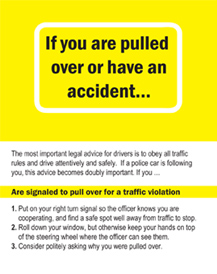Requests for admissions in a rear-end collision
Lawyers investigate things about a lawsuit in a variety of ways. One of these is the pre-trial phase of a lawsuit called “discovery.” One of the typical discovery methods is to ask the other side to admit to certain things.
The sample requests for admissions shown below are for the specific situation when the defendant driver caused a car accident by rear-ending the plaintiff’s car. If you were hit in a rear-end collision, then your personal injury lawyer might use requests for admission similar to these.
Technical issues in rear-end car accident lawsuits
The braking distance for a vehicle is the distance that is required to stop the car traveling at a specific highway or roadway at a particular speed. Distance is calculated using a distance-to-stop formula as follows:
Drag factor is the coefficient of friction plus or minus grade of the roadway. It is expressed as the percentage of the weight of an object required to push it or pull it along any surface.
Car accident reconstruction experts can determine the drag factor of a roadway at a particular location and the drag factor can then be used to make the distance-to-stop calculations.
Once the defendant’s speed has been determined and a drag factor established, then minimum braking distance can be calculated.
In addition to braking distance, the distance traveled between the driver’s perception time and reaction time must also be taken into account. Reaction time is the time that it takes the driver to react by applying brakes once a danger is perceived. The reaction time of an average driver is three-quarters of a second, although in certain circumstances, drivers may have a perception time in excess of two seconds. These may include difficulties in road conditions, or alcohol or drug impairment.
Request for admissions to a defendant in a rear-end car accident lawsuit
1. Admit that on (date) the vehicle Defendant was driving came into contact with the rear of the car in which the Plaintiff was driving (or was a passenger).
2. Admit that at the time of the collision, there were no obstructions to your vision.
3. Admit that at the time just prior to the collision, Defendant was traveling at a speed that did not allow him to bring the car to a complete stop without striking the car that the Plaintiff was driving (or in which the Plaintiff was a passenger) in the rear.
4. Admit that Defendant failed to see Plaintiff’s car in sufficient time to take appropriate action to avoid hitting the car in which Plaintiff was driving (or was a passenger).
5. Admit that there was not sufficient distance between Defendant’s car and the Plaintiff’s car (or the car in which the Plaintiff was a passenger) to allow Defendant sufficient time to avoid hitting it.
6. Admit that Defendant failed to apply the brakes prior to hitting the Plaintiff’s car (or the car in which the Plaintiff was a passenger).
7. Admit that Defendant failed to apply the brakes with sufficient time to avoid hitting the Plaintiff’s car (or the car in which the Plaintiff was a passenger).



